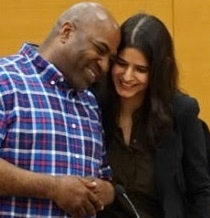 (Photo of Andre Hatchett and Innocence Project attorney Seema Saifee courtesy of Innocence Project) Shortly before midnight on February 18, 1991, the body of 38-year-old Neda Mae Carter was found naked and beaten in Monroe Street Park in the Bedford-Stuyvesant neighborhood of Brooklyn, New York. She had been arranged in a cruciform—her arms were straight out to her sides and her legs were crossed at the ankles. Scrapes on her body indicated she had been dragged to the location where she was discovered.
Carter lived in a rooming house with her mother. Earlier in the evening, 24-year-old Andre Hatchett came to visit his aunt, who also lived in the rooming house, as he did nearly every day. During his visit, he saw Carter. He cooperated with police during the immediate investigation and provided alibi information. At the time, he was wearing a cast on his right leg and using crutches because he was recovering from gunshot wounds.
About a week later, Gerard “Jerry” Williams was arrested by New York police on an unrelated burglary charge. He told the arresting officer that he had information about the murder and gave a statement to a detective and two prosecutors that he and a woman nicknamed “Popeye” were in the park when they heard a woman scream. About 35 to 40 feet away, they saw a man swinging his arm over a body on the ground. At first he said the man was someone whom police had already interviewed and had a crutch, but later told police he never saw a crutch.
That night, Hatchett, who was learning disabled and could barely read or write, voluntarily came to the police station where he was put in a lineup and identified by Williams. Despite this identification, Hatchett was not arrested and he was allowed to leave the precinct.
Williams also was released and helped police find “Popeye,” who, on March 26, 1991, also viewed a lineup containing Hatchett. At first she was unsure and selected someone else, but then changed her mind and selected Hatchett, who was arrested that same day and charged with murder.
In October 1991, Hatchett went to trial in Kings County Supreme Court. Williams testified and identified Hatchett as the man he saw swinging at the victim. “Popeye” was not called as a witness.
At the end of the trial, the judge declared a mistrial because of inadequate legal defense provided by Hatchett’s defense lawyer. The judge cited the attorney for numerous failures, including failing to serve notice to the prosecutor of an alibi defense, for non-existent or minimal cross-examination of witnesses, and for repeatedly conducting conferences with Hatchett or the prosecutor in a voice loud enough for the jury to hear. The judge noted that the lawyer was hearing impaired and could not hear all of the testimony.
Hatchett went to trial for a second time in February 1992. Again Williams testified and, as he did in the first trial, denied that he had received any favorable treatment from the prosecution relating to his burglary charge in exchange for his testimony. At the time, Williams had nearly two dozen prior convictions.
On February 19, 1992, the jury convicted Hatchett of second-degree murder. He was sentenced to 25 years to life in prison.
Neither of Hatchett’s defense lawyers presented medical records showing that at the time of the crime, Hatchett was on crutches and wearing a leg cast and was physically unable to commit the crime.
Ultimately, the Innocence Project teamed up with lawyers from the firm of Paul, Weiss, Rifkind, Wharton & Garrison LLP. After re-investigating the case, they requested that the Brooklyn District Attorney’s Conviction Review Unit (CRU) re-examine the evidence.
The CRU discovered evidence in the District Attorney’s file that Williams had initially identified another person as the killer – not Hatchett – and that Williams was smoking crack on the day of the crime. That information had not been disclosed to Hatchett’s defense lawyers. In addition, records showed that the burglary charge for which Williams was arrested on the night he came forward as an alleged eyewitness to the homicide was dismissed.
On March 10, 2016, Assistant District Attorney Mark Hale, head of the Conviction Review Unit, moved to vacate the conviction and dismiss the case. “Mr. Hatchett should never have been charged with this homicide,” Hale said, adding that the prosecution of Hatchett was a “systemic failure” of the criminal justice system.
The case was the 19th conviction to be vacated through the work of the Conviction Review Unit under Brooklyn District Attorney Kenneth Thompson.
In March 2017, Hatchett filed a federal wrongful conviction lawsuit. In October 2017, the city of New York settled the lawsuit for $12 million. Hatchett also filed a claim for compensation in the New York Court of Claims and received $2.5 million in 2021.
– Maurice Possley
|